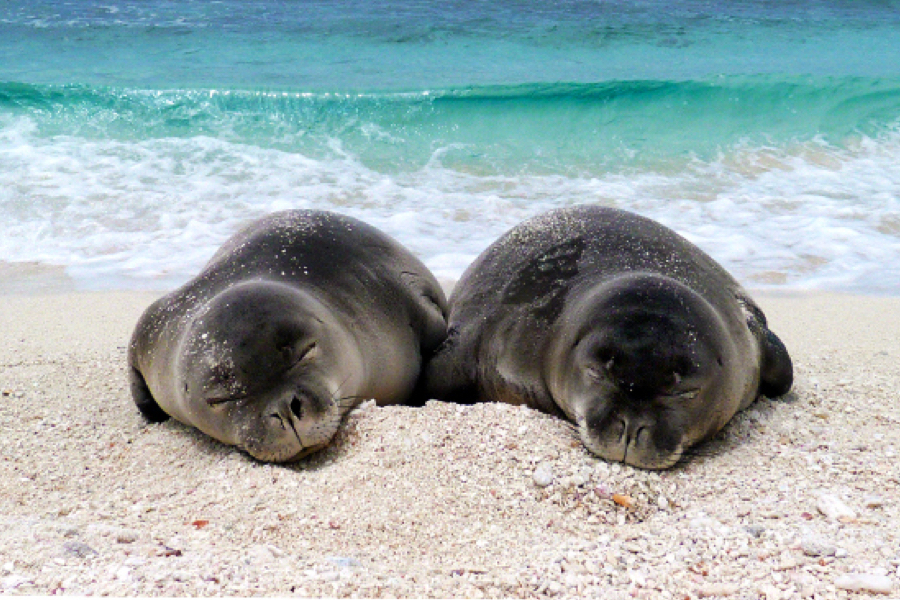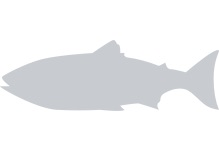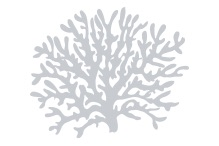Sustainable Seafood
Sustainable Seafood
Sustainable seafood is wild-caught or farmed seafood that is harvested or produced in ways that protect the long-term health of species populations and ecosystems. The United States is a global leader in sustainable seafood. U.S. fishermen and seafood farmers operate under some of the most robust and transparent environmental standards in the world. If the seafood you purchase is caught or farmed in the United States, you can feel confident you’re making a sustainable seafood choice.
Marine wild-capture fisheries in the United States are scientifically monitored and regionally managed. They are enforced under 10 national standards of sustainability through the Magnuson-Stevens Act—exceeding the international standards for eco-labeling of seafood.
Although current U.S. aquaculture production is small and lags behind the rest of the world, U.S. fish farms operate under some of the world’s most robust environmental protections. They produce environmentally safe, sustainable sources of domestic seafood. They also create jobs, support resilient working waterfronts and coastal communities, and provide international trade opportunities.

Our sustainable seafood profiles have up-to-date information on the status of some of the nation’s most valuable marine species harvested in U.S. federal waters. They also have information on U.S. farmed fish that help meet our country’s growing seafood demand.
Watch the video below to get a tour of the new home of FishWatch.
Featured News
 Fresh-caught taʻape on ice. Credit: Conservation International Hawaiʻi.
Fresh-caught taʻape on ice. Credit: Conservation International Hawaiʻi.
Reducing Waste and Feeding Communities in Hawaiʻi with a Whole Fish Approach
 Chef Tyler Hadfield’s Curried Skate Wings with Tomato-Masala Chutney
Chef Tyler Hadfield’s Curried Skate Wings with Tomato-Masala Chutney
Ring In the New Year With These Crowd-Favorite Seafood Recipes
 NOAA Fisheries, in collaboration with Blue Ocean Mariculture, is conducting a multi-year pilot study to evaluate observational methods and tools for studying Hawaiian monk seal behavior. Courtesy of Blue Ocean Mariculture
NOAA Fisheries, in collaboration with Blue Ocean Mariculture, is conducting a multi-year pilot study to evaluate observational methods and tools for studying Hawaiian monk seal behavior. Courtesy of Blue Ocean Mariculture
AI Meets Aquaculture to Study Hawaiian Monk Seal Interactions With Net Pens
 Tonya Wick aboard a fishing vessel at sea in 1998. Photo courtesy of Tonya Wick
Tonya Wick aboard a fishing vessel at sea in 1998. Photo courtesy of Tonya Wick
19.2 pounds of fish and shellfish
In 2019, the average American ate 19.2 pounds of fish and shellfish, an increase of .2 pounds over the year prior.
$219 million generated by oyster aquaculture.
In 2018, the top U.S. marine aquaculture species were oysters ($219 million), clams ($122 million), and Atlantic salmon ($66 million).
9.3 billion pounds of seafood
In 2019, U.S. commercial fishermen landed 9.3 billion pounds of seafood valued at $5.5 billion.
1.8 million jobs supported by fisheries
In 2019, commercial and recreational fishing industries supported 1.8 million jobs and generated $255 billion in sales impact.
Information for Seafood Consumers
Get up-to-date information on the status of some of the nation’s most valuable marine fish harvested in U.S. federal waters as well as U.S. farmed fish that help meet our country’s growing seafood demand. Also learn about buying and handling seafood, fraud, and health and nutrition.
Seafood Inspection
The NOAA Fisheries Seafood Inspection Program provides inspection services to the seafood industry that help them comply with food safety regulations. This helps ensure that the seafood on your plate is fresh, safe, and sanitary.
Illegal, Unreported, and Unregulated Fishing
IUU fishing occurs when fishing or seafood businesses circumvent conservation and management measures and avoid the operational costs associated with sustainable fishing practices. IUU fishing undermines the reputation of legitimate fishing and seafood operations and the consumer confidence on which they rely. We work with partners around the world to combat this complex international issue.
Market News
Since 1938, we’ve been working with industry to provide accurate and unbiased reports depicting current conditions affecting the trade in fish and fishery products.
Foreign Trade (Imports and Exports)
We also maintain a foreign trade database dating back to 1975 that allows users to summarize U.S. foreign trade in fish products. You can summarize the weight and dollar value by year, product, country, and type of trade. This data comes from the Foreign Trade Division of the U.S. Census Bureau, which is responsible for compiling information submitted by importers and exporters to the U.S. Customs and Border Protection.
Trade/Import Monitoring
As part of our mission to sustainably manage fishery resources, we implement international trade monitoring programs initiated by international fishery management organizations or required by domestic law.
Understanding Sustainable Seafood
Well-managed wild-capture fisheries and environmentally responsible marine aquaculture play an increasingly important role in our food supply, our health, and the environment.

Multimedia
 Fresh-caught taʻape on ice. Credit: Conservation International Hawaiʻi.
Fresh-caught taʻape on ice. Credit: Conservation International Hawaiʻi.
Reducing Waste and Feeding Communities in Hawaiʻi with a Whole Fish Approach
 Fish on display at the market. Credit: Shutterstock
Fish on display at the market. Credit: Shutterstock
 A chef prepares various finger foods made from squid fins in the Dr. Matthew Highlands Food Pilot Plant in Hitchner Hall at the University of Maine. Several chefs were invited to create dishes as part of a research project to develop new frozen foods made from squid fins. Photo courtesy of the University of Maine.
A chef prepares various finger foods made from squid fins in the Dr. Matthew Highlands Food Pilot Plant in Hitchner Hall at the University of Maine. Several chefs were invited to create dishes as part of a research project to develop new frozen foods made from squid fins. Photo courtesy of the University of Maine.
Understanding Sustainable Seafood
Well-managed wild-capture fisheries and environmentally responsible marine aquaculture play an increasingly important role in our food supply, our health, and the environment. Understanding and achieving a sustainable seafood supply is an ever-evolving journey. We continually monitor our dynamic ocean resources to determine whether overfishing is happening and respond quickly with appropriate measures. This adaptive approach to management fosters responsible wild-capture fisheries. Today, more than 90 percent of the stocks we monitor are not subject to overfishing. By prioritizing sustainability, the U.S. fish farms that were once plagued by environmental issues are now some of the most environmentally efficient food production facilities in the world.
What is sustainable seafood?

Sustainable seafood is fish, shellfish, and seaweeds harvested or farmed in a manner that provides for today’s needs while allowing species to reproduce, habitats to flourish, and productive ecosystems to be available for future generations.
It’s also the most environmentally efficient source of protein on the planet. In the United States, wild-caught and farmed fish, shellfish, and seaweeds are managed under a system of enforced environmentally responsible practices. Both sources are essential for ensuring sustainable supplies of seafood for our nation and the world.
Is U.S. seafood sustainable?

Yes. U.S. seafood is inherently sustainable due to our robust and dynamic science-based regulatory system. From wild-capture fisheries to farmed fish facilities, the United States is a recognized global leader in sustainable seafood.
U.S. wild-capture marine fisheries are conducted under science-based fishery management plans developed by regional fishery management councils through an open, public process. These plans are developed using the best scientific information available. By law, U.S. seafood must be caught according to fishery management plans that:
- Consider social and economic outcomes for fishing communities
- Prevent overfishing
- Rebuild depleted stocks
- Minimize bycatch and interactions with protected species
- Identify and conserve essential fish habitat
Through this process, fish populations are managed to provide for today’s needs while allowing the species to reproduce and be available for future generations. Learn more about wild fisheries management in the United States.
How does NOAA Fisheries make sure U.S. fisheries are sustainably managed?

U.S. fisheries are scientifically monitored, regionally managed, and legally enforced under 10 national standards of sustainability. Managing sustainable fisheries is a dynamic process. It requires constant attention to new scientific information, so that management actions can adapt to changing ocean conditions.
Fishery managers use a variety of scientific information—including stock assessments and species and ecosystem research—to set harvest and operational requirements for each fishery. These requirements support the goals of sustaining fish populations, protecting habitat and other species, and keeping fishermen on the job.
If a species is overfished, this management system allows for restricted harvest levels to rebuild the stock and keep responsible fishermen on the water and fishing communities at work. You can be assured the U.S. seafood you see at the store is being actively managed for today’s consumers and future generations.
What role does aquaculture play in sustainable seafood?

Although the sustainability of our domestic wild-capture fisheries continues to improve, we cannot meet increasing domestic demand for seafood through wild-caught fisheries alone. Over the past 30 years, global wild-capture fisheries have plateaued while aquaculture has become the fastest growing form of food production worldwide. The United States produces a relatively small amount of seafood from aquaculture. We rely heavily on foreign aquaculture imports to meet the growing demand for healthy protein.
It is critical for the United States to expand the aquaculture industry. By growing our seafood locally, we can ensure a safe, secure, and sustainable local seafood supply. Marine aquaculture also creates jobs, supports resilient working waterfronts and coastal communities, and provides new trade opportunities.
How does the United States contribute to sustainable fisheries internationally?

The United States is a global leader in conservation and sustainable seafood. Our nation is one of the largest consumers and importers of seafood in the world. U.S. standards for seafood products have a major impact on the sustainability of the world’s global seafood trade.
The United States has interests as both a seafood-consuming nation and a fishing nation. It is critical that we take an active role in shaping the conservation and management of international fisheries. To achieve this goal, NOAA Fisheries:
- Supports U.S. participation in a number of international fisheries agreements
- Takes steps to address global illegal, unreported, and unregulated fishing
- Provides technical assistance to other countries interested in the U.S. fisheries management system
Learn more about international cooperation for sustainable fisheries and seafood
Seafood Consumers
Want to eat more seafood and support the U.S. seafood industry but don’t know where to start? Our sustainable seafood profiles arm you with the facts about what makes U.S. seafood sustainable—from tide to table. Get up-to-date information on the status of federally managed and farmed marine fish and shellfish.
Health

Seafood is a healthy food choice, providing key nutrients and healthy protein for everyone from infants to adults. Seafood supplies the nutrients essential for strong bones, brain development, and healthy immune and cardiovascular systems. The Dietary Guidelines for Americans recommend adults eat at least 8 ounces of seafood per week. The guidelines also have specific advice for pregnant or nursing mothers and children.
- Eating Fish: What Pregnant Women and Parents Should Know
- USDA Food Patterns
- Mercury in Seafood
- Advisories and Technical Resources for Seafood Consumption
Buying and Handling

When buying seafood, choose knowledgeable, reputable dealers—those you trust with a known record of proper handling practices. Once you’ve made your seafood purchase and take it home, be sure to “keep it cold, keep it moving, and keep it clean.” Follow our tips below!
Learn more about buying seafood
Learn more about handling and storing seafood
Recipes

Agriculture and Consumer Services.
Lemon butter shrimp, New England style clam chowder, Parmesan crusted swordfish, and more! Looking for a new seafood dish or an old favorite? If you need some cooking inspiration, browse these seafood recipes for main dishes, appetizers, sides, and more!
Inspection and Safety

The Food and Drug Administration runs a mandatory fish inspection program for all seafood processors and retailers, both domestic and international. This program monitors seafood at critical points along the supply chain to prevent food safety problems. NOAA Fisheries also manages a voluntary, fee-for-service program that works with other agencies to provide science-based inspection services to the seafood industry to ensure safe, high-quality seafood. Together, we ensure the seafood that enters the U.S. marketplace is safe and wholesome for the consumer.
Learn more about seafood inspection
Mislabeling and Fraud

Studies and investigations have found that seafood fraud is committed along the supply chain. Types of fraud range from simple misunderstandings or lack of information to blatant deception to increase profits and attempts to launder illegally harvested seafood. With new and growing partnerships and evolving technologies, we are working across federal agencies and the seafood supply chain to safeguard the sustainability and integrity of seafood in the U.S. marketplace.
Learn more about seafood fraud
Sustainable Seafood Across the Globe

The United States is a significant importer of seafood. Much of that comes from China, Thailand, Canada, Indonesia, Vietnam, and Ecuador. And half of the imported seafood is harvested through aquaculture. NOAA Fisheries is committed to building a level playing field for U.S. fishermen and seafood farmers, advancing sustainable management practices internationally, and strengthening consumer confidence in safe and legal seafood.
- Understanding illegal, unreported, and unregulated fishing
- Foreign fishery trade data
- Global aquaculture
U.S. Seafood by the Numbers

Each year we produce three reports on the status of U.S. marine fisheries. The reports take a detailed look at the fisheries and track important indicators such as annual seafood consumption and the productivity of top fishing ports.
Seafood Industry
The U.S. seafood industry is incredibly diverse. NOAA Fisheries, working with federal, local, and non-governmental partners, provides support services for fishermen, producers, processors, and other industry professionals.
National Seafood Strategy
Our National Seafood Strategy was released in 2023 after five years of collaborative development with all sectors of the seafood industry. The strategy—an outgrowth of President Trump’s 2020 Executive Order Promoting American Seafood Competitiveness and Economic Growth—outlines NOAA Fisheries’ direction for supporting a thriving domestic U.S. seafood economy. It describes our approach to enhancing the resilience of the seafood sector—both wild-capture and aquaculture—in the face of changing environmental conditions and other stressors. The strategy is organized by four overarching goals:
- Goal 1: Maintain or increase sustainable U.S. wild capture production
- Goal 2: Increase sustainable U.S. aquaculture production
- Goal 3: Foster access to domestic and global markets for the U.S. seafood industry
- Goal 4: Strengthen the entire U.S. seafood sector
Our accompanying National Seafood Strategy Implementation Plan guides the agency’s industry services in support of seafood production and community resilience. It identifies activities NOAA Fisheries can take or is taking to help address important national issues.
Learn more about NOAA’s National Seafood Strategy and Implementation Plan
Fisheries Data

We compile and publish data on fisheries landings, the U.S. fishery processing industry, imports and exports, and other indicators important to seafood industry professionals. Much of the data is collected by NOAA Fisheries scientists, fishery observers, and regional, state, and academic partners. We also work with fishermen and farmers, importers and exporters, processors, distributors, and retailers to ensure we are capturing an accurate picture of our seafood economy.
- Fisheries landings
- Fisheries of the United States
- Per capita consumption
- Processed products
- Foreign fishery trade data
- Fishery Market News
Community and Ecosystem Data

We study a range of indicators to understand the status and trends of ecosystems and the communities that rely on ocean resources. This information helps resource managers analyze the costs and benefits of different activities and understand the impacts of management decisions.
- Commercial fisheries economics
- Protected species economics research
- Marine protected area economics research
- Marine ecosystem indicators
International Competitiveness

We are committed to building a level playing field for U.S. fishermen and seafood farmers and expanding opportunities for the U.S. seafood industry. Our work is focused on sustainably expanding domestic production, keeping illegal, unreported, and unregulated products out of U.S. markets, and strengthening global marine stewardship.
- Expanding domestic aquaculture
- Combating IUU fishing
- Exporting sustainable fishing and conservation practices
- Engaging with international trade organizations
- Enforcing international agreements
- Seafood Import Monitoring Program
Financial Support
NOAA Fisheries and our partners administer funds, grants, and other financial services to support seafood professionals. These provide short- and long-term assistance, support for research and innovation, and coverage for certain losses.
Seafood Inspection and Certification

Our Seafood Inspection Program is a voluntary, fee-for-service program that helps the seafood industry improve the quality, safety, and marketability of U.S. seafood and fishery products. This includes export certification services to facilitate the export of U.S. products.
Seafood Science

Our science-based conservation and management ensures optimum production, enhances our nation’s food security, and supports consumer confidence in U.S. seafood products. Industry professionals play a valuable role in our science through cooperative research programs. NOAA scientists and our partners also work to understand and address issues of importance to the seafood industry, including offshore wind development and climate change.
Seafood Communities
A truly sustainable seafood industry also sustains the many communities that rely on that seafood for their livelihoods, cultural practices, and nutrition. Indeed, sustaining the participation of fishing communities in our fisheries is one of the explicit goals of the National Standards governing federal fisheries regulations. NOAA Fisheries’ work directly impacts the economic opportunities, health, and environment of many communities, both domestic and international.
U.S. Seafood Community
Ultimately, NOAA Fisheries can only carry out our mission of ensuring safe and sustainable seafood by working with a diversity of people. We support research, conservation initiatives, technological innovation, and community outreach. We fund institutions and organizations made up of those people—the anglers, commercial fishermen, aquaculturists, seafood companies, tribes, scientists, nonprofits, coastal communities, beachgoers, and more. Their expertise and perspectives directly influence how we manage fisheries and aquaculture, and protect marine mammals and endangered species, as we develop and enforce regulations that are fair and equitable.

Faces of Seafood
Have you ever wondered how your seafood gets to your plate? Some may think the only players in the seafood supply chain are the people who catch the fish and the people who sell it. But with more than a million jobs supported by the U.S. seafood industry, the roles are as diverse as the people who fill them. A truly sustainable seafood industry also sustains the many communities that rely on that seafood for their livelihoods, cultural practices, and nutrition.
Learn more about the people who support U.S. seafood
Fishing Community Profiles

To better understand how changes in fishery regulations may impact different groups of people, we have created profiles of regional fishing communities. The profiles portray each community’s past and current engagement in fisheries. They also contain basic information on the social and economic characteristics of these communities. These reports allow us to assess the social and economic impacts of policies and regulations at the community level, an examination required by various federal statutes.
Using Social Science to Benefit Communities

We conduct additional economic and socio-cultural research beyond the fishing community profiles. This ensures we consider the needs of all of the people that depend on the living marine resources that we manage.
Economic and socio-cultural analyses help fisheries managers evaluate the benefits and costs of different activities, prioritize needs, and encourage policies that maximize societal benefits from ocean and coastal resources. By studying both the social and economic aspects of communities, we strive to manage fisheries and protected species in a way that balances the perspectives of multiple communities and fisheries-related disciplines.
Learn more about NOAA Fisheries’ socioeconomics research
Global Seafood Community
The United States is a global leader in conservation and sustainable seafood. Our nation is one of the largest consumers and importers of seafood in the world. U.S. standards for seafood products have a major impact on the sustainability of the world’s global seafood trade.
Strengthening Global Marine Stewardship

We work closely with foreign governments, foreign entities, and international organizations to promote conservation and sustainable fisheries management internationally.
- International engagement
- International and regional fisheries management organizations
- International fisheries agreements
Combating Illegal, Unreported, and Unregulated Fishing

Illegal, unreported, and unregulated fishing describes a wide variety of fishing-related activities that violate both national and international fishing regulations. These activities significantly undermine U.S. and global efforts to sustainably manage fisheries and conserve marine resources. As a result, IUU fishing threatens food security and upsets the economies of coastal communities around the world. NOAA Fisheries is one of several federal agencies working together to effectively address this critical issue.
- Understanding IUU fishing
- Identification of IUU fishing activities
- Keeping IUU fishing products out of U.S. markets
Improving Fisheries Governance

The lack of information and oversight in fisheries management among some developing nations has resulted in declining marine stocks, many of which are vital to providing fish to the local markets. We encourage various fisheries governance projects and programs to achieve effective and responsible marine stewardship and ensure sustainable global fisheries management.
International fisheries governance efforts
Conserving International Species and Reducing Bycatch

The United States is a leader in promoting the global conservation of marine mammals, sharks, tunas, sea turtles, and seabirds. One of the ways we work to conserve these species internationally is by helping foreign countries reduce bycatch. We support bilateral and multilateral cooperative efforts that work on the ground to reduce bycatch, including data collection efforts and projects to improve bycatch reduction technologies.











